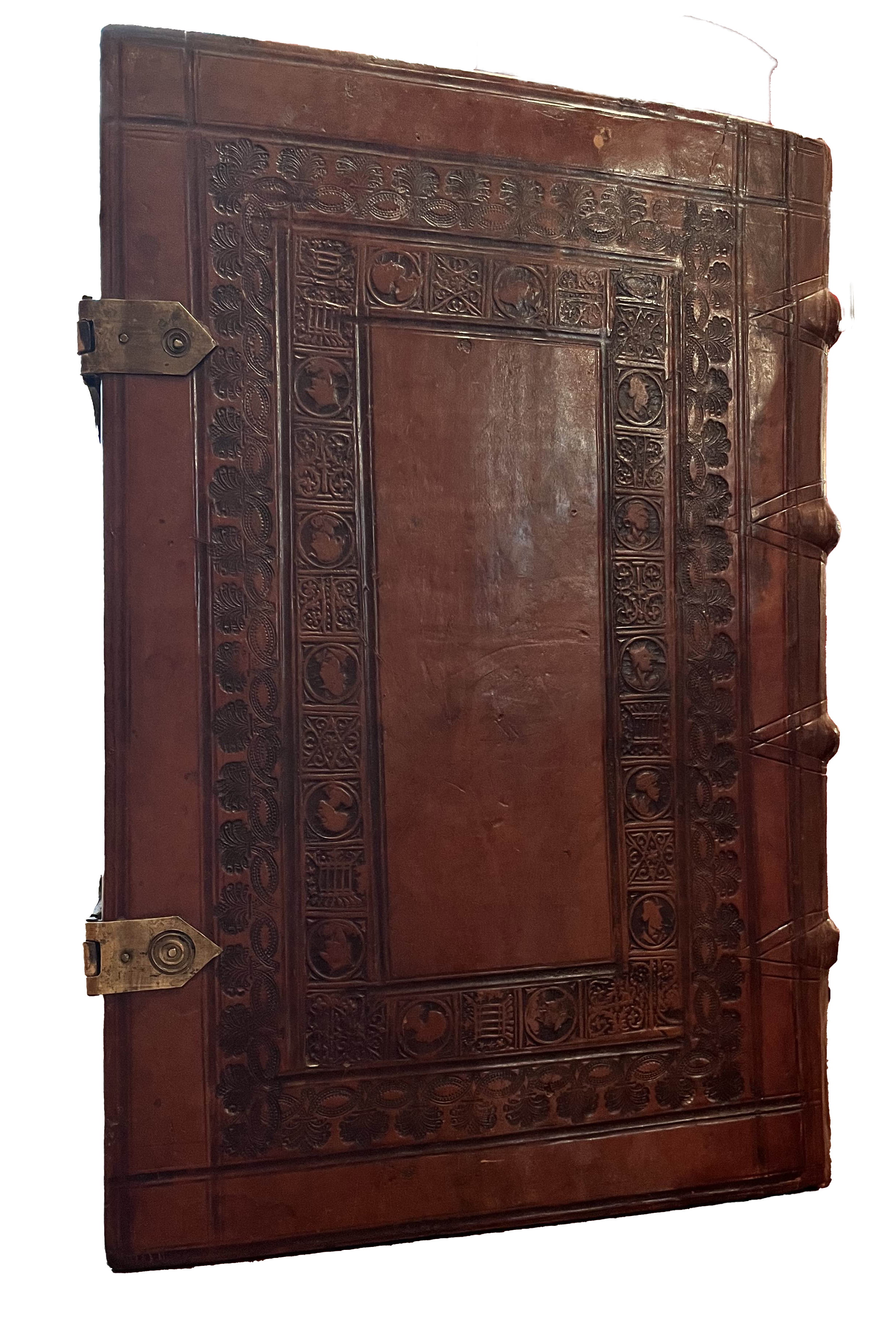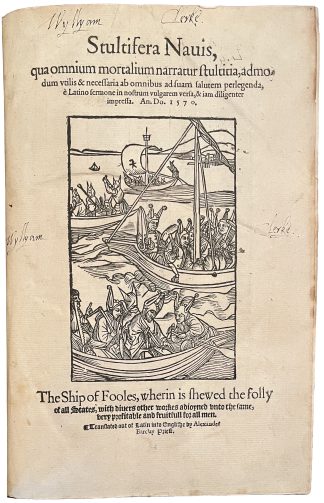BRANT, Sebastian.
HANDSOME CONTEMPORARY BINDING, CUTS BY DÜRER
Stultifera navis. The ship of fooles.
[London, J. Cawood], 1570.£85,000.00
Small folio. ff. [12], 259, [3], [42], [24]. Black letter, with Roman. Woodcut title vignette and 116 ½-page woodcuts depicting Fools’ paradise, decorated initials and ornaments. A handful of ll. at end very slightly browned, minor water stain to lower blank margin, the odd little marginal spot or mark. A very good, clean, amazingly crisp, well-margined copy in contemporary English calf over wooden boards, rebacked to style, original spine onlaid, two clasps (repaired), double blind ruled to a panel design, outer border with blind roll of interlacing palmettes, inner border with blind roll of heads within circles alternating with geometrical decorations (Oldham, HM a (6) 775), feps renewed. Early ms casemark and Estelle Doheny’s bookplate to front pastedown, contemporary autograph ‘Wyllyam Clerke’ to title. In folding box by James Brockman.
A fine, clean copy, virtually unpressed, in contemporary London binding, of the second English edition, including the Latin text, of this most influential and handsomely illustrated satire on human folly. A German humanist from Strasbourg, Sebastian Brant (1458-1521) completed his studies at Basel. There, he published his major works, the most renowned, ‘Das Narrenschiff’, in 1494. The humanist Jakob Locher translated it into Latin as ‘Stultifera navis’ in 1497. ‘Stultifera navis’ is a powerful satirical poem. ‘In a ship laden with one hundred fools, steered by fools to the fools’ paradise of Narragonia, Brant satirizes all the weaknesses, follies and vices of his time. Composed in popular humorous verse and illustrated by a remarkable series of woodcuts—of which 75 are now attributed to the young Dürer—the book was an immediate success’ (PMM 37). The nautical theme was probably strengthened under the influence of contemporary debates on voyages of exploration and the vanity of seeking knowledge of God’s creation. Most famous is the chapter on the ‘inquisition of geographical regions’, or the foolishness of those who want to measure the earth, illustrated by a fool’s-capped figure holding a compass. It also mentions Columbus’s discoveries. The work opens with the Fool-Book Collector – a most amusing satire of bibliophiles and ‘unprofitable books’. In Barclay’s translation, this bespeckled Fool is ‘busy, books assembling, / For to have plentie it is a pleasant thing’. Albeit he does not read or study them, yet he has them ‘in great reverence’, keeps them ‘safe from filth and ordure / By often brushing and much diligence’, and likes to have them ‘bound in pleasaunt coverture, / Of Damas [damask], Sattin or els of Velvet pure’.
The English translation, first made for Pynson’s 1509 edition, is by the Scottish poet and clergyman Alexander Barclay (1476-1552). ‘The English “Ship of Fools” exercised an important direct influence upon our literature, […] helping to bury medieval allegory in the grave […], and to direct English authorship into the drama, essay, and novel of character’ (DNB). Barclay’s first major publication, it was based on the German, Latin (in particular) and French texts, including ‘free additions and unconscious adaptation [of the original] to the manners of a new nation of readers’ (Morley, p.93), having, for instance, the foolish priests who ‘no scripture think […] so true nor good / As is the foolish deeds of Robin Hood’, national ‘types’ such as Jack Charde or Robin Hill, and sections based on ancient or continental geography rewritten with a focus on Britain and Ireland (with its dwellers ‘Denis and Moris, Patrike and Mackmurre’, dressed in mantles ‘for lack of precious fur’). Barclay and Pynson’s novelty were the printed marginal glosses and ‘envoys’, assisting the reader with sources and citations. ‘This second edition […] contains the cuts from the previous English edition of 1509; all but 7 derive from those in the first edition of the “Narrenschiff” (Basel, 1494). […] Added in the English editions are cuts 68, 76, 86, 101-104’ (Luborsky & Ingram 3546). At the end are appended Barclay’s translation of Mancin’s ‘The Mirrour of Good Manners’, a poem on the cardinal virtues, and Barclay’s own English eclogues.
The early owner, William Clerke (fl.1590s), may be the author of ‘The Triall of Bastardie’ (1594) and ‘Polimanteia’ (1595), one of the earliest known works mentioning Shakespeare’s name. Estelle Doheny (1875-1958) was a collector and philanthropist, wife of the oil tycoon Edward L. Doheny. A most discerning bibliophile, she amassed a library of major early Western works in fine copies, including specimens of the Gutenberg Bible, subsequently dispersed through several sales. Acquired from Robinsons of Pall Mall, their description enclosed.
ESTC S107135; STC (2nd ed.), 3546; Pforzheimer, 41; Luborsky & Ingram, 3546. H. Morley, English Writers (1891).In stock









